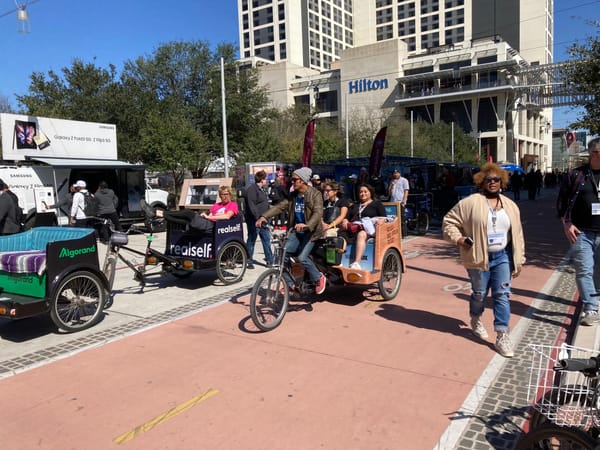A very scary situation at the airport
Can the city do something about this?

I was convinced that Indigenous Peoples Day, formerly Columbus Day, was a city holiday. Alas, a number of city employees regretfully informed me yesterday that it is not. My bad.
A damning report on air traffic control at AUS
An investigation by the New York Times highlighted the near fatal-consequences of the Austin-Bergstrom Airport's understaffed and ill-equipped air traffic control system.
On a cold, foggy Saturday morning in February, an air traffic controller cleared a FedEx cargo plane to land on Runway 18L at Austin-Bergstrom International Airport in Texas. A Southwest Airlines jet was on the same runway, but the controller said it would take off before FedEx’s hulking Boeing 767 got too close.
As the FedEx plane descended through thick clouds, though, the pilots saw something terrifying: the silhouette of the Southwest 737. The two planes were seconds from colliding.
One of the FedEx pilots commandeered the air traffic control radio frequency. He ordered Southwest to abort its takeoff. It didn’t. The FedEx crew blasted the engines to climb away from the Southwest plane. “On the go,” a FedEx pilot radioed.
The FedEx plane, which had three crew members, skimmed less than 100 feet over the other jet. The 128 people aboard Southwest Flight 708 continued on their way to Cancún, Mexico. Passengers were unaware that they had nearly died.
In a year filled with close calls involving U.S. airlines, this was the one that most unnerved federal aviation officials: A disaster had barely been averted, and multiple layers of the vaunted U.S. air-safety system had failed.
Austin is merely one of many victims of systemic understaffing and underinvestment at the FAA:
Austin-Bergstrom, like the vast majority of U.S. airports, lacks technology that allows controllers to track planes on the ground and that warns of imminent collisions. The result is that on foggy days, controllers can’t always see what is happening on runways and taxiways. Some have even resorted to using a public flight-tracking website in lieu of radar.
In addition, for years Austin has had a shortage of experienced controllers, even as traffic at the airport has surged to record levels. Nearly three-quarters of shifts have been understaffed. Managers and rank-and-file controllers have repeatedly warned that staffing levels pose a public danger. The controller on that February morning was working an overtime shift.
In June, Stephen B. Martin, then Austin’s top manager, and a local union representative wrote a memo pleading for more controllers. “Drastic steps are needed to allow the facility to adequately staff for existing traffic,” they wrote to F.A.A. and union officials.
Just to make this clear: the city of Austin has no official role to play in staffing air traffic controllers, who are federal employees. Similarly, the city does not control the number of security personnel, shortages of which have been blamed for long lines and occasionally havoc at the airport in recent years.
Nevertheless, I reached out to city airport officials to see what they had to say.
Airport spokesperson Samantha Haynes said that the "recurrence of these events at airport across the country is concerning," and that the shortage of labor and technology are "federal challenges."
Haynes said that in 2003 the FAA began implementing a new type of Airport Surface Detection Equipment (ASDE-X), which was put in place in 35 airports in the U.S. Austin was not one of them.
"The technology is no longer available to airports and the program has been discontinued," she said. "AUS has in the past and recently inquired to the FAA how we can receive this equipment and the FAA has confirmed to us that it is not available."
That's weird. Apparently the FAA is seeking newer and perhaps more cost-effective technology.
City leaders may have no official role to play in addressing this issue, but that doesn't mean they can't do anything. They can raise hell and put pressure on the FAA and U.S. DOT to deliver some much-needed relief to America's fastest growing airport.
One step closer to eliminating parking minimums
Last night the Planning Commission voted 9-0-1 to recommend an ordinance to City Council eliminating off-street parking requirements.
This is the fruit of a resolution approved by Council in May that directed staff to draft an ordinance scrapping parking minimums. There was no shortage of concerns among urbanist advocates that staff would find a way to complicate what was a very straightforward policy command, but it looks like staff pulled it off.
Only one person came out to speak against the proposal. And only one person on the dais –– Commissioner Jennifer Mushtaler –– expressed opposition. Mushtaler ultimately abstained.
The proposed ordinance retains requirements for handicapped parking spaces, but eliminates all others.
Again, this does not outlaw new parking or in any way restrict the amount of parking a developer can provide. It simply eliminates the requirement that they build parking. As pointed out by Commissioner Greg Anderson, the central business district has lacked parking requirements for years and there is still tons of new parking being added in developments there.




